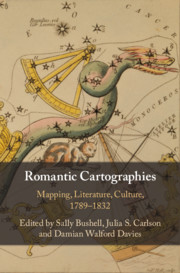Book contents
- Romantic Cartographies
- Romantic Cartographies
- Copyright page
- Contents
- Illustrations
- Notes on Contributors
- Preface
- Acknowledgements
- Introduction Romantic Cartographies
- Part I Romantic Maps, Romantic Mapping
- Chapter 1 Cartography and Natural History in Late-Eighteenth-Century Canada
- Chapter 2 ‘That Experienced Surveyor, Colonel Mudge’
- Chapter 3 The British Atlas
- Chapter 4 Mapping Invasion
- Part II Cartographic Encounters
- Part III Beyond Romantic Cartographies
- Bibliography
- Index
Chapter 1 - Cartography and Natural History in Late-Eighteenth-Century Canada
from Part I - Romantic Maps, Romantic Mapping
Published online by Cambridge University Press: 15 January 2021
- Romantic Cartographies
- Romantic Cartographies
- Copyright page
- Contents
- Illustrations
- Notes on Contributors
- Preface
- Acknowledgements
- Introduction Romantic Cartographies
- Part I Romantic Maps, Romantic Mapping
- Chapter 1 Cartography and Natural History in Late-Eighteenth-Century Canada
- Chapter 2 ‘That Experienced Surveyor, Colonel Mudge’
- Chapter 3 The British Atlas
- Chapter 4 Mapping Invasion
- Part II Cartographic Encounters
- Part III Beyond Romantic Cartographies
- Bibliography
- Index
Summary
The First Voyage of Captain Cook on the Endeavour is often seen as inaugurating a new kind of scientific expedition in which ships functioned both as the primary instrument for the production of global maps and as floating natural history laboratories in which information concerning indigenous people, plants, and animals extended across the globe. This chapter examines the intellectual links between these forms of colonial knowledge-making by discussing the manner in which they first came together in Canada in Moses Harris’s Porcupine Map (1750). The map provides the first published illustrations of Canadian insects; it is also one of the last maps to include representations of indigenous flora and fauna. The task of visualizing global natures would be taken up by the descriptive technologies of natural history. As Cook and Banks were renaming the landforms and biota of the South Pacific, the Hudson’s Bay Company was mapping places and animals, drawing on the knowledge and names provided by indigenous peoples. Although the indigenous understanding of places and animals underwent erasure, these early maps and natural histories are valuable for voicing both European conceptions of new and unfamiliar places and natures and those of indigenous peoples.
Keywords
- Type
- Chapter
- Information
- Romantic CartographiesMapping, Literature, Culture, 1789–1832, pp. 27 - 49Publisher: Cambridge University PressPrint publication year: 2020

